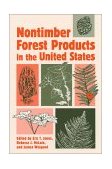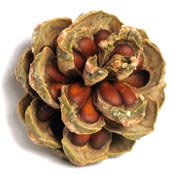Non-Timber Forest Products

Eric T. Jones
Read Book Review at the end of the page, order book
Co-Director
Institute for
Culture and Ecology
What are Non-Timber Forest Products?
Nontimber forest products (NTFP), also referred to as Special
Forest Products, encompass all forest species other than tree
parts used for timber. They include both commercial and
potentially commercial species. NTFP is not a biological
category but rather a political economic category useful for
highlighting the lost value when timber is the primary focus of
forest managers. Oregon's vast temperate forests have both an
extensive diversity and density of nontimber forest products.
Examples of NTFPs in Oregon include wild mushrooms, ferns,
ornamental plants, floral greens, medicinal plants, cones, and
much more.
Why are NTFP's an important component to sustainable forestry?
Essentially, NTFP's can be used to supplement or supplant timber
cutting from forests ecosystems. Even-aged timber management,
the most common form of forest management in Pacific Northwest
forests, typically contributes to a decline in forest health
through reducing complex ecological systems to monocrop tree
plantations. Active management for NTFP's, on the other hand, can
potentially maintain ecosystem complexity and play an important
role in restoring biodiversity and balance to damaged forests.
Furthermore, extraction of a broader range of natural resources,
other than just timber products, can lead to economic diversity
and stability for rural forest communities, thereby contributing
to greater regional economic stability.
How could these products help me add value to my forestland?
Even with little active management of NTFP's, these industries
have been growing rapidly and have been contributing millions of
dollars annually to the Pacific Northwest since the mid-1980's.
By managing forestland so that NTFP diversity is allowed to
flourish, one can potentially increase the long-term value of a
forest while simultaneously playing an important role in forest
conservation.
What kinds of resources exist in the state to help me develop
this aspect of my land?
Currently, existing NTFP businesses have most of the information
about NTFP markets, production, and regulations. However,
forestry extension agents, sustainable development
organizations, environmental consulting firms, and more are
starting to become more knowledgeable about NTFP's. Let these
businesses and groups know you are interested in exploring NTFP
options and ask for their help.
What are some of the other issues associated with NTFP's?
Gathering forest species in the region we call Oregon, for food,
medicine, shelter, and other uses, dates back to the first human
inhabitants. Euroamerican pioneers who settled in Oregon also
gathered nontimber resources from the forests. Some of these
traditions continue to this day and are an important part of our
heritage and are embedded in the cultural fabric. Thus, it is
important that new commercial industries respect and not
undermine these noncommercial use patterns.
Most NTFP extraction is done by harvesters working by hand. In
Oregon, thousands of people make part or all of their living as
harvesters. Some of these people are employees of businesses,
but many are independent contractors with a vested interest in
the well-being of the forest areas they harvest. Many talk about
the joy of working in the woods and their efforts to steward the
land and resources they depend upon. In recent years forest
managers have restricted access to NTFP harvesters, squeezing
them into smaller areas of the forest, increasing competition
and tension between harvesters, and undermining stewardship
incentives. To avoid these problems, managers, harvesters, and
all other stakeholders need to work closely together to educate
each other and construct sensible management approaches.
H-NET BOOK REVIEW-http://www.h-net.msu.edu/
Published by H-Environment@h-net.msu.edu H-Net: Humanities &
Social Sciences (December 2003)
Eric T. Jones, Rebecca J. McLain and James Weigand, eds. Nontimber
Forest Products in the United States_. Development of
Western
Resources Series.
Lawrence: University of Kansas Press, 2002. xxv + 424
pp. Map, tables,
graphs, notes, bibliography for each chapter, index.
$60.00 (cloth),
ISBN 0-7006-1165-7; $29.95 (paper), ISBN 0-7006-1166-5.
Reviewed for H-Environment by James G. Lewis, Visiting Scholar, Forest History Society, Durham, NC
Exposing Nontimber Forest Products to Daylight
went against its traditional principles of forest resource management that aimed at generating high volumes of lumber and wood fiber. The decision has meant that the Forest Service and the sixteen additional federal agencies that followed suit now must "account for the effect of any
management actions on a much broader array of species and harvesting activities than in the past" (p. 349). Instead of environmental impact
statements, environmental assessments, and other land planning documents concentrating almost exclusively on timber, nontimber forest products must now be given equal consideration.
nineteenth-century and early-twentieth-century conservation reforms, the study of NTFP's has long been overshadowed by the study of timber. In
forest and conservation historiography, in other words, one could not see the nontimber forest products for the trees.
Nations Food and Agricultural Organization (FAO), the workshop's sponsor, backed out in 1999, and the Canadian and Mexican partners soon thereafter dropped out because they lacked funding. The U.S. team decided to continue and shifted its focus away from a description of state-of-the-art scientific and management knowledge about NTFP's to a harder "analysis of key U.S. policy issues, research directions, and management concerns" (p. xiv).
authors, and which has since been expanded and is set up to aid other researchers.
In setting the parameters for the project, the editors chose to use the FAO's definition of NTFP's, which encompasses five broad product
categories: foods; floral greenery and horticultural stocks; medicinal plants and fungi; fiber and dye plants, lichens, and fungi; and oils,
resins, and other chemical extracts from plants, lichens, and fungi. The definition is broad enough to include everything from forests
relatively unmodified by humans to those that exist only because of human intervention. In addition, the authors narrowed the definition and limited the discussion to include botanical species only. Because the focus in several essays is on food and medicinal products, not "historical" or industrial products like naval stores, some forest historians may be disappointed. Again, it should be emphasized that this work was not intended as a historical survey or examination, but rather as an introduction to the state of research on NTFP's.
Though the book includes the work of more than thirty contributors drawn from the fields of economics, ecology, law, history, forestry, anthropology and other social sciences, the editors can rightfully boast that they have for the most part avoided the kind of wild stylistic variation that can easily mar compilation books. The contributions are grouped into five sections: "Past and Present," "Commerce and Conservation," "Native American Claims," "Policy and Management," and "Customary Claims to Use Rights on Public Lands." The section named "Policy and Management" is a bit misleading, however. That section focuses on NTFP tenure issues at the federal level; the editors decided not to include a discussion of issues at the state level, but note in their introduction the need for further study on that level. Because of space considerations, they also opted not to examine private and non-government organization (NGO) sector resource management policies; international resource management and trade policies; and other issues like labor and human health and safety issues, but urge that comparable efforts deal with them be undertaken.
Each section begins with one or more essays designed to provide context for the case studies that follow. (The exception is the last section, which consists of just one essay. The author includes some case studies within the essay.) The case studies further explore some of the ideas
presented in the essays and point toward areas for further study. For example, "Past and Present" contains two instructive essays: one on the
historical uses of NTFP's in the northeastern United States and the other on the relevance of sociocultural variables to nontimber forest product
research, policy, and management. They are followed by eight case studies that deal with various regions or locations, including ones on the
American Pacific Tropics and the Caribbean Basin. That James Weigand wrote five of the eight studies serves to underscore the dearth of
experts on NTFP's in the United States.
Given the paucity of studies and secondary source material on NTFP's in the United States, the inclusion of essays and a case study that discuss
conservation and economic models developed outside North America further highlights just how little attention American policymakers and leaders have devoted to the topic. Nan Vance's essay, "Ecological considerations in Sustainable Use of Wild Plants," scrutinizes ecological
sustainability issues in the face of rising consumer demand for herbal medicines and other NTFP's. And, in their essay, "The Paradox of Market-Oriented Conservation: Lessons from the Tropical Forests," Carolyn Crook and Roger Alex Clapp warn that American land managers should be aware of certain perils in managing forests for the commercial exploitation of NTFP's before embracing any overseas model. Thomas Love echoes that
assertion in his case study of western Amazonian rubber tappers and Brazil nut harvesters.
Nontimber Forest Products_ is an important work, and its problems are very minor. For example, while each essay and case study has its own
bibliography, considering the need to encourage further scholarship in the field, a bibliographic essay or a list of additional readings that point the reader to other leading works would have been helpful. However, given the very lack of secondary sources, this may be easier to ask for than to carry out. Though common and scientific names of plants are incorporated into the text and are also compiled in two handy appendices, it is not clear why the small amount of information found in the other appendices (such as "Estimating Commercial Quantities of Floral Greens" or
"Traditional Forestry Methods to Inventory Tree Characteristics") were not simply incorporated into existing essays. Nonetheless, inclusion in any form is welcome. Minor organizational problems aside, the book fills a substantial void in American forest and conservation history literature.
By bringing attention to a neglected topic, it charts the course for future study not only by historians, but by anthropologists, economists, ecologists, forest management and policy specialists and others as well.
Copyright (c) 2003 by H-Net, all rights reserved. H-Net permits the redistribution and reprinting of this work for nonprofit, educational purposes, with full and accurate attribution to the author, web location, date of publication, originating list, and H-Net: Humanities & Social Sciences Online.For other uses contact the Reviews editorial staff: hbooks@mail.h-net.msu.edu.
The following publications have a more complete discussion of NTFP issues:




